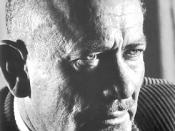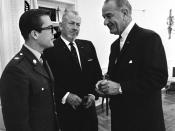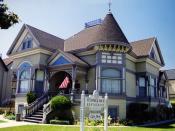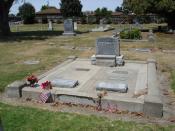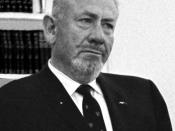The novella Of Mice and Men by John Steinbeck shows the misadventures of two migrant workers in 1920 California. Steinbeck's life and the times greatly influenced his writing of this book. Through Steinbeck's writing he explores the theme of loneliness and uses the symbols of animal imagery and escape to help support his theme and give his characters life.
John Steinbeck was born in Salinas California. He was the third of four children. He grew up in Salinas, the town in many of his stories. He was once a student at Stanford but left without a degree. He died of arteriosclerosis in New York. This is the basic view of John Steinbeck's life.
Yet looking deeper into Steinbeck's life many of his stories reflect influences in his life. He uses Salinas, The town he was raised in, as the backdrop of many of his stories. Steinbeck also uses many regions in the fertile area of California.
"A few Miles south of Soledad, the Salinas River"æ" This is an actual area that Steinbeck was familiar with. Also in his intricate description of nature, almost turning it into it's own character reflects part of his life. "The Idea of nature should assume such an important place in Steinbeck's work isn't surprising. His closest friend, Ed Ricketts, trained him to be a natural scientist. Steinbeck spent many hours of his adult life in a laboratory in Monterey CA, where Ricketts taught him scientific method for studying marine life in the laboratory." (Pg. 1) Even after Steinbeck had moved to New York he always spoke fondly of the area. After his death he was cremated there.
Another influence on Steinbeck's book Of Mice and Men was the plight of the 1920's. The entire country had sunk into a depression. In Of Mice and Men the poverty of Lennie and George reflects that. Migrant workers of the time had not set up the unions that organized during the 1940's. Many people in the depression only route of fantasy was the movies. "Coulda been in the movies an' had nice clothes"æ" This was the time when the rest of the country looked at actors as more than actors but as ideals. They led glamorous lifestyles and set fashion trends.
The book Of Mice and Men examines the theme of loneliness. Steinbeck used migrant workers as the lead and supporting characters in his book because they were the epitome of loneliness. Traveling from place to place for work, making wherever they slept a home. The characters of Lennie and George stand out though. Lennie , a strong tall but mentally handicapped man, sticks to George. Together they create a small family. ""æbecause I got you to look after me, and you got me to look after you"æ" quotes Lennie commenting on the family situation. Together they plan a life on a small farm living out the dream of having a place to call home. Many of the other characters attempt to find someone. The old man called Candy keeps an old dog. Everyone attempts to talk him into shooting the crippled old dog.
"That dog ain't no good to himself. I wish somebody'd shoot me if I get old and a cripple." (Steinbeck p. 50) But Candy loves the dog and persists in keeping it. " I don't mind takin' care of him" (Steinbeck p. 50) Eventually Candy gives in and shoots the dog, which is foreshadowing to George shooting Lennie. To cope with loneliness many of the guys go to a brothel called Old Suzy's. Crooks, an old crippled black stable hand, experiences real loneliness. Being the only black man on the ranch the other guys isolate him due to his color. He talks about how much this hurts "I tell ya a guy gets too lonely an' he gets sick." Curly's wife exhibits her loneliness by spending time with the boys in the bunkhouse. Curly is possessive and attempts to keep her on a short leash. Being the only woman on the farm makes her lonely and sad for curly doesn't want her talking to the men. "'I get lonely.' She said "ÃÂYou can talk to people but I can't talk to nobody but Curly. Else he gets mad. Else he gets mad. How'd you like not to talk to anybody?'" (Steinbeck p. 95) Two more of the dominant symbols in Of Mice and Men are animal imagery and the idea of escape. Many of the characters in Of Mice and Men are described by animal characteristics. Lennie is described as ""æa huge man ..with wide sloping shoulders and he walked heavily, dragging his feet a little, the a bear drags his paws." (Steinbeck p. 2) George, on the other had, is Lennies opposite, described as ""ædefined, small, strong hands, slender arms, a thin bony nose." (Steinbeck p. 2) He is described as almost a fox like creature, whereas Lennie is more like a bear. The older man, Candy, is described almost like his old dog.
The idea of escape is also found through out Of Mice and Men. Lennie and George, by envisioning their own plot of land, are trying to think of an escape from their lives. Getting a plot of land serves as an escape plan for many of the farm hands in Steinbeck's novella.
"You're nuts' Crook's was scornful. I seen hundreds of men come and by on the road an' on the ranches "æ and that same damn thing on their heads." "Steinbeck p." Curly's wife uses the idea of going off to Hollywood and being a star as an escape from reality. George and Lennie ge an escape at the end through means they never thougt. By shooting Lennie, Lennie is released from a life that could never accept him. Lennie was much like Candy's old dog, both were too much to handle. It also released George from sacrificing himself to help take care of Lennie.
All of the ideas that go on in Steinbeck's Of Mice and Men can be applied today. Candy shooting his dog and George shooting Lennie are two types of Euthenasia, or assisted suicide. The theme of loneliness is carried on today also. Many people find themselves traveling from place to place, like foster children, without anyone but themselves and no real place to setup and call home. Runaways are constantly escaping from reality and looking for a way to better the life they left and a place of their own to call home, much like many of the characters in John Steinbeck's Of Mice and Men.
